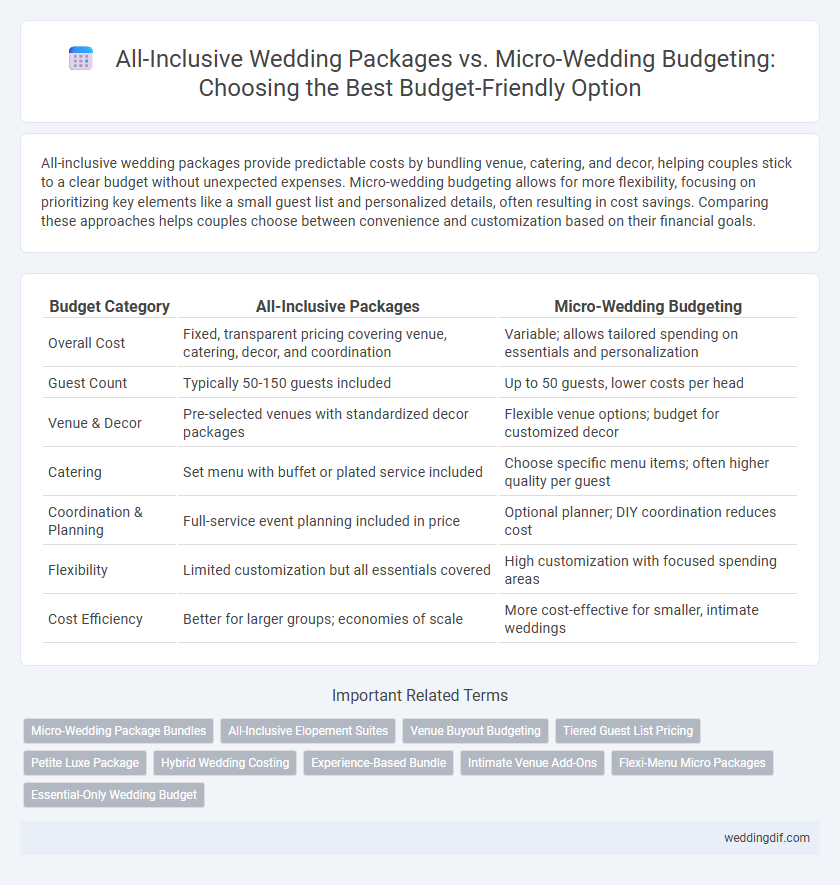All-inclusive wedding packages provide predictable costs by bundling venue, catering, and decor, helping couples stick to a clear budget without unexpected expenses. Micro-wedding budgeting allows for more flexibility, focusing on prioritizing key elements like a small guest list and personalized details, often resulting in cost savings. Comparing these approaches helps couples choose between convenience and customization based on their financial goals.
Table of Comparison
| Budget Category | All-Inclusive Packages | Micro-Wedding Budgeting |
|---|---|---|
| Overall Cost | Fixed, transparent pricing covering venue, catering, decor, and coordination | Variable; allows tailored spending on essentials and personalization |
| Guest Count | Typically 50-150 guests included | Up to 50 guests, lower costs per head |
| Venue & Decor | Pre-selected venues with standardized decor packages | Flexible venue options; budget for customized decor |
| Catering | Set menu with buffet or plated service included | Choose specific menu items; often higher quality per guest |
| Coordination & Planning | Full-service event planning included in price | Optional planner; DIY coordination reduces cost |
| Flexibility | Limited customization but all essentials covered | High customization with focused spending areas |
| Cost Efficiency | Better for larger groups; economies of scale | More cost-effective for smaller, intimate weddings |
Understanding All-Inclusive Wedding Packages
All-inclusive wedding packages offer a streamlined budgeting solution by bundling venue, catering, decor, and entertainment costs into a single price, reducing the risk of unexpected expenses. These packages provide clear cost visibility and simplify financial planning, making them ideal for couples seeking a hassle-free approach. Understanding the components and limitations of these packages ensures a realistic budget and helps avoid overspending compared to the flexible but often unpredictable micro-wedding budgeting method.
What Is Micro-Wedding Budgeting?
Micro-wedding budgeting involves allocating funds specifically for a smaller, more intimate celebration typically under 50 guests, allowing for higher quality choices in venues, catering, and decor within a limited budget. This approach emphasizes prioritizing essential elements while reducing overall expenses by cutting down guest count and extras, leading to significant savings compared to traditional or all-inclusive wedding packages. Couples benefit from greater flexibility and control over personalization and spend distribution, optimizing their budget to create a meaningful and memorable event.
Upfront Costs: All-Inclusive vs Micro-Wedding
All-inclusive wedding packages often feature a fixed upfront cost that covers venue, catering, decor, and entertainment, simplifying budgeting by consolidating expenses into a single payment. Micro-wedding budgeting typically involves itemizing each component separately, resulting in lower initial costs but requiring detailed cost management for venue rental, catering, and vendors. Comparing upfront costs, all-inclusive packages provide financial predictability, while micro-weddings offer flexibility to allocate funds based on priority services and guest count.
Breakdown of Typical Micro-Wedding Expenses
Micro-wedding budgeting typically involves itemized expenses such as venue rental, catering per person, floral arrangements, photography, and attire, often totaling between $5,000 and $15,000 depending on location and guest count. In contrast, all-inclusive packages bundle these services into a single price, offering convenience but with less customization flexibility. Couples prioritizing cost control and personalized details often prefer micro-wedding budgeting to optimize spending across key elements.
Hidden Fees in All-Inclusive Packages
All-inclusive wedding packages often present hidden fees that can significantly inflate the overall budget, including service charges, gratuities, and mandatory vendor add-ons not initially disclosed. Micro-wedding budgeting offers more transparency by allowing couples to selectively allocate funds toward essential elements, minimizing unexpected costs. Careful comparison of contract details and a clear understanding of included services are essential to avoid financial surprises in all-inclusive deals.
Customization Flexibility and Impact on Budget
All-inclusive wedding packages offer convenience with fixed pricing but often limit customization options, which can restrict personalized touches and potentially inflate costs for unique requests. Micro-wedding budgeting allows couples to allocate funds more precisely, prioritizing specific elements like bespoke decor or gourmet catering, enhancing flexibility without unnecessary expenditure. Tailoring expenditures in micro-weddings typically results in a more controlled and potentially lower overall budget compared to the bundled nature of all-inclusive deals.
Guest List Size and Its Financial Effects
All-inclusive packages often simplify budgeting by offering fixed rates that cover venue, food, and entertainment for a set guest list size, making costs predictable but less flexible for varying attendance. Micro-wedding budgeting allows couples to tailor expenses closely to a smaller guest list, significantly reducing overall costs per head while enabling customization of each spending category. The guest list size directly influences vendor pricing, with smaller groups benefiting from micro-wedding budgets that minimize per-person costs, whereas larger weddings might find all-inclusive deals more cost-effective.
Value for Money: Comparing Inclusions
All-inclusive wedding packages offer bundled pricing that typically covers venue, catering, decor, and entertainment, providing a comprehensive solution with predictable costs, ideal for couples seeking convenience and value. Micro-wedding budgeting allows for tailored spending, often allocating more funds to premium experiences or personalized details, resulting in potential cost savings but requiring meticulous management to avoid overspending. Comparing inclusions reveals that all-inclusive deals streamline vendor coordination and reduce hidden fees, while micro-weddings offer greater flexibility to prioritize high-impact elements aligned with the couple's unique preferences.
Saving Strategies for Both Wedding Types
All-inclusive packages streamline budgeting by bundling venue, catering, and decor costs, often offering discounts that reduce overall expenses for couples. Micro-weddings allow for flexible allocation of funds, enabling targeted spending on personalized elements like boutique venues and specialty meals while cutting costs on large-scale logistics. Strategic prioritization and comparing vendor packages can maximize savings in both wedding types, balancing quality and budget constraints effectively.
Choosing the Best Option for Your Budget
All-inclusive wedding packages offer a fixed price covering venue, catering, and decor, simplifying budgeting and reducing unexpected expenses. Micro-weddings require detailed planning and may allow more flexibility, often lowering overall costs by limiting guest numbers and customization. Evaluating your priorities and comparing detailed cost breakdowns helps determine the best option to maximize value and stay within your wedding budget.
All-Inclusive Packages vs Micro-Wedding Budgeting for weddings Infographic

 weddingdif.com
weddingdif.com